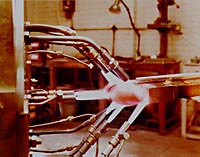Flame brazing (Torch Brazing)
by John Fernie
Flame brazing uses a gas flame to melt and flow the filler metal. Common fuel/gas mixtures are acetylene, hydrogen, or propane, mixed with oxygen or air.
Flame brazing is performed in air, and normally requires the use of a flux. It is a versatile process which can be applied to a large range of metal alloys and joint geometries.
The brazing filler metal is either fed in the form of wire or rod, or it is pre-placed. Care must be taken in the placement of filler metal to prevent premature melting. One way to prevent overheating is to use flux with a melting temperature
just below the filler metal, thereby giving a visual indication of temperature.
Depending on the fuel type and air/oxygen flow rates, the flame characteristics can be selected to be carburising, neutral or reducing.
Manual flame brazing
This is the preferred method for repairs, one-of-a-kind brazing jobs, and short production runs.
Uniform heating of the joint can be accomplished by multiple-tipped torches, or the use of more than one torch.
Automated flame brazing
For large production quantities, part or all of the flame brazing operation may be automated. The degree to which the process can be automated depends on factors such as -
- component size and configuration
- joint accessibility
- desired production rate
- labour needed to handle the components
- filler to be used
 |
Multi-jet mechanised torch brazing
(Courtesy of Solbraze)
|
Advantages of flame brazing
- requires relatively low initial investment in equipment
- less operator skill required for automated flame brazing
- manual flame brazing equipment is generally portable
- same equipment used in gas welding/cutting can be used for most manual flame brazing operations
- joints with relatively poor fit-up can be brazed
Disadvantages of flame brazing
- flux residue must be removed after brazing, otherwise there is potential risk of corrosion
- use of flux results in joints having a higher degree of porosity than those made in a controlled atmosphere
- reactive metals and ceramics cannot be flame brazed
|
